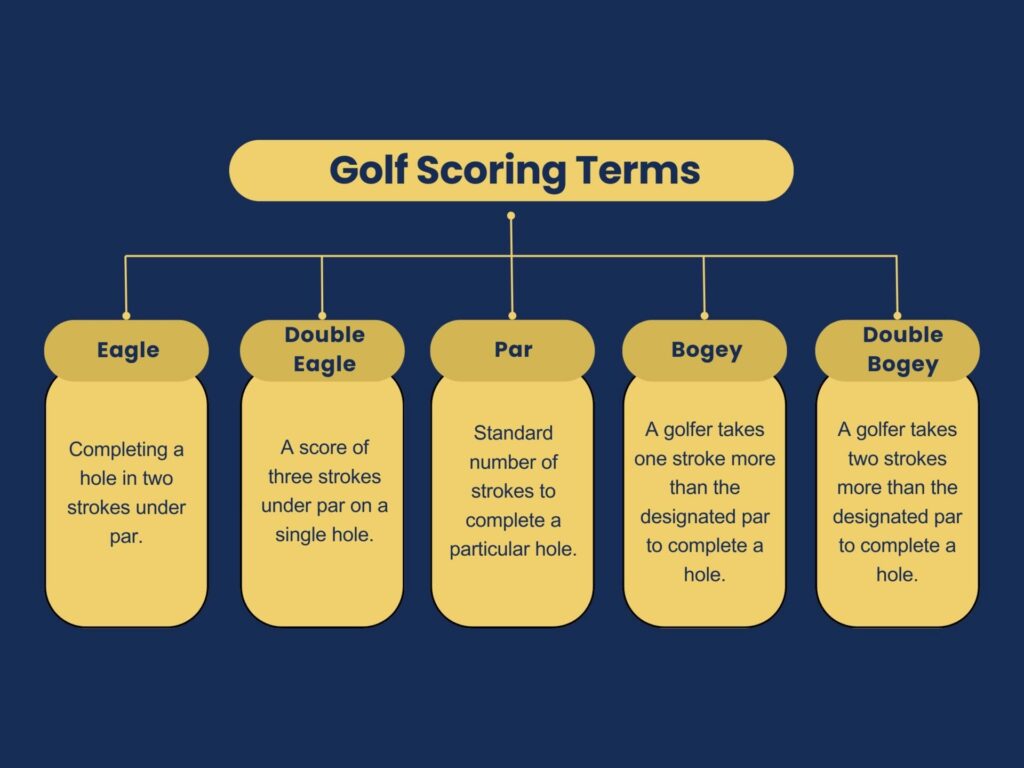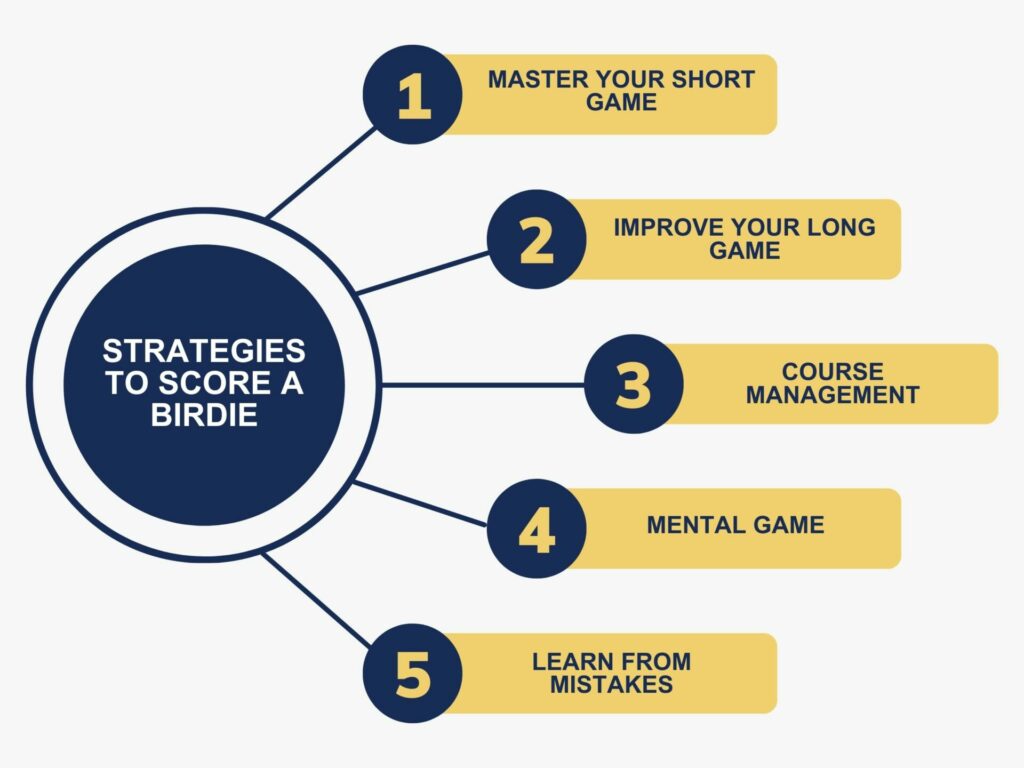
Golf terms like ‘birdie’ frequently flutters around, representing a significant achievement for golfers of all skill levels. By focusing on precision and strategy, golfers can increase their chances of scoring birdies and achieving lower scores overall.
But what is a birdie in golf, and more importantly, how can an enthusiastic golfer score one? Read on to learn useful tips on how to elevate your golf game.
Understanding Golf Scoring Terms
Before diving into birdies, let’s quickly recap the scoring system in golf. Golf courses consist of a series of holes, each with a designated ‘par’, representing the expected number of strokes expert golfers should take to complete the hole.
The common pars are three, four, or five, depending on the length and difficulty of the hole.
Understanding the intricacies of golf scores is essential for aspiring golfers seeking to unlock the coveted achievement of a birdie and improve their performance on the course.
If you’re looking for in-depth insights, organisations like the United States Golf Association (USGA) offer guidance and standards in the sport. Their commitment to the sport’s integrity and development is a source of inspiration for golfers worldwide.

The Golf Scorecard Terminology:
1. Eagle
Achieving an eagle in golf means completing a hole in two strokes under par. Eagles are considered exceptional and are often a result of a particularly skilful shot or a successful combination of shots.
2. Double Eagle
A double eagle refers to a score of three strokes under par on a single hole. It’s a rare and impressive accomplishment in the game. The term is more commonly used in the United States and is usually called an “albatross” in other parts of the world.
3. Par
Par represents the standard number of strokes that an expert or skilled golfer is expected to take to complete a particular hole or the entire course. Matching par is the baseline goal for golfers, and achieving it reflects solid, consistent play. Holes are typically classified as par 3, par 4, or par 5.
4. Bogey
A bogey occurs when a golfer takes one stroke more than the designated par to complete a hole. While bogeys are slightly unfavourable, they are a common part of the game and don’t necessarily indicate poor performance.
5. Double Bogey
It refers to a score where a golfer takes two strokes more than the designated par to complete a hole. Double bogeys are a bit more challenging to recover from, and golfers aim to minimise such scores to maintain a competitive position during a round.
What Does Birdie Mean?
The word “birdie” in golf has an interesting origin, rooted in American golf history. It traces back to the early 20th century. The story goes that in 1903, Ab Smith hit a great shot and exclaimed that it was a “bird of a shot” during a golf game at the Atlantic City Country Club in New Jersey.
This phrase at the time was a common American expression used to refer to anything excellent. Smith’s group decided that if one scored under par on a golf hole, it would be called a “birdie.”
The concept quickly caught on, and as golf grew in popularity, this golf term spread and became a standard part of golfing terminology.
A birdie occurs when a golfer scores one stroke less than the designated par for any given hole. For instance, if a hole is a par-four and you sink your ball in just three strokes, congratulations, you’ve scored a birdie!
Making a birdie is considered a noteworthy accomplishment in golf, and it often brings a sense of satisfaction and achievement to players.

What Are The Different Ways to Make a Birdie?
Scoring a birdie in golf requires a combination of skill, strategy, and mental focus, which highlight the golfer’s ability to navigate the course efficiently. A birdie putt isn’t the only way to achieve it. Here are some effective ways to make a birdie:
- One-Putt: Make the ball into the hole with a single putt after reaching the green.
- Approach Shot: Hit the ball close to the pin with your approach shot, making it easier to putt for a birdie.
- Long Drive: A powerful and accurate drive off the tee can set up an easier approach to the green.
- Chip-In: Chip the ball into the hole from off the green with a short shot.
How Golf Course Designers Keep Players on Their Toes
Most golf courses are meant to make it difficult for players to consistently score birdies in order to strike a balance between providing an enjoyable experience for players of various skill levels while challenging them to showcase and improve their skills.
Some challenges include:
1. Course Layout
Hazards: Golf courses often include hazards such as water bodies, bunkers, rough terrain, and out-of-bounds areas strategically placed throughout the course. These obstacles add an extra layer of difficulty for golfers to hit accurate shots and reach the green in fewer strokes.
2. Green Design
Contoured Greens: Greens are often designed with slopes, undulations, and breaks, making it difficult for golfers to predict the path of their putts accurately. This requires a keen understanding of the terrain and skilful putting to sink the ball in fewer strokes.
Green Speed: Groundskeepers can adjust the speed of the greens by controlling the length of the grass. Faster greens are a greater challenge for golfers, as they must be more precise with their putting.
3. Distance and Par
Yardage: Longer holes and greater overall course length mean that an average golfer can struggle to reach the green in fewer strokes, especially if they lack the necessary distance off the tee.
Par: Golf courses come with a specific par for each hole, which represents the number of strokes an expert golfer should take to complete the hole. Meeting or beating par isn’t easy for most golfers.
4. Tee Box Placement
Tee Box Variations: Golf courses typically have multiple tee boxes for each hole, allowing players to choose an appropriate starting point. The farther back the tee box, the more challenging the hole becomes.
5. Strategic Design
Doglegs: Holes with doglegs (fairways that bend left or right) require golfers to strategically plan their shots to play the course effectively.
Strategic Bunkering: Bunkers in landing zones or around greens force players to carefully consider their shot placement and club selection.

Strategies to Score a Birdie
Now that you’ve got a better understanding of what a golf course can look like and what the term “birdie” means, let’s dive into some essential tips to increase your chances of scoring one:
1. Master Your Short Game
- Putting: Precision in putting is crucial. Practice various putting techniques and understand the greens.
- Chipping: Work on your chipping to get close to the hole on your approach shots.
2. Improve Your Long Game
- Driving: A strong, accurate drive can significantly reduce the distance to the hole, setting you up for a potential birdie.
- Iron Play: Practising with your irons will help in making accurate approach shots, a key component in setting up birdie opportunities.
3. Course Management
- Plan Your Shots: Analyse each hole and strategise your shots. Sometimes, playing it safe is better than taking risky shots.
- Know the Course: Familiarise yourself with the course layout, particularly the pars and hazards.
4. Mental Game
- Stay Positive: Golf is as much a mental game as it is physical. Keep a positive mindset.
- Focus: Concentrate on each shot and stay in the moment.
5. Learn From Mistakes
- Analysing mistakes and learning from them is vital in improving your golf skills. Identify areas of weakness and work on those aspects of your game to enhance overall performance.

Practice Makes Perfect
Like any aspect of golf, scoring birdies consistently comes down to practice. Spend time on the driving range, practice your putting, and play as many rounds as you can. Each round is an opportunity to learn and improve.
By focusing on your short and long game, managing the course smartly, and maintaining a strong mental attitude, you’ll find yourself closer to achieving those coveted birdies.
Remember, every great golfer started with a single birdie, so keep practising and stay patient. Your next birdie is just a swing away!
Trophy Events is a premier provider of sports hospitality, offering tailored corporate packages for various events. Our diverse offerings include private box access, VIP privileges to exclusive areas, and luxurious dining experiences. Get in touch today to enhance your sporting experience with Trophy Events!






